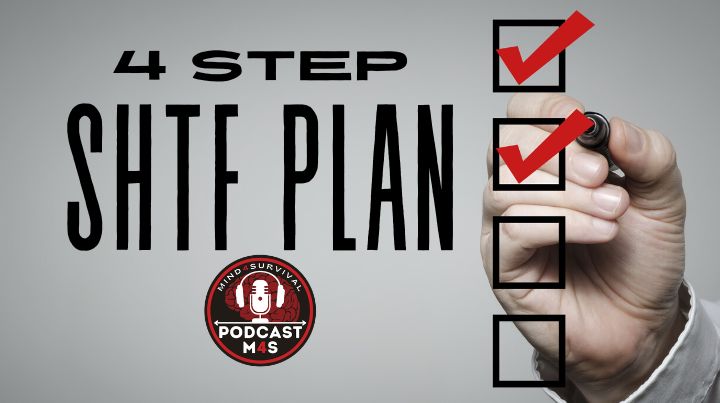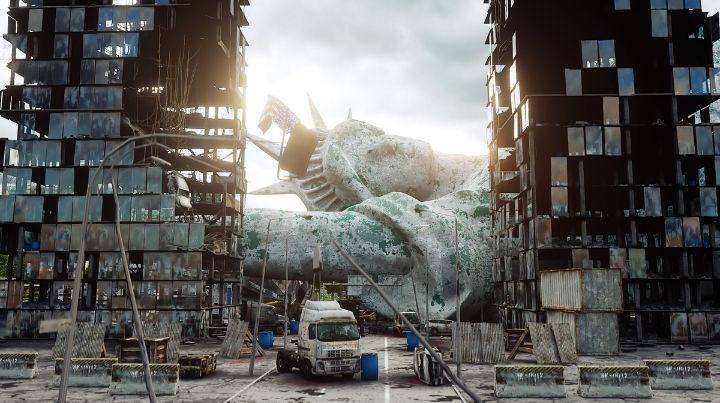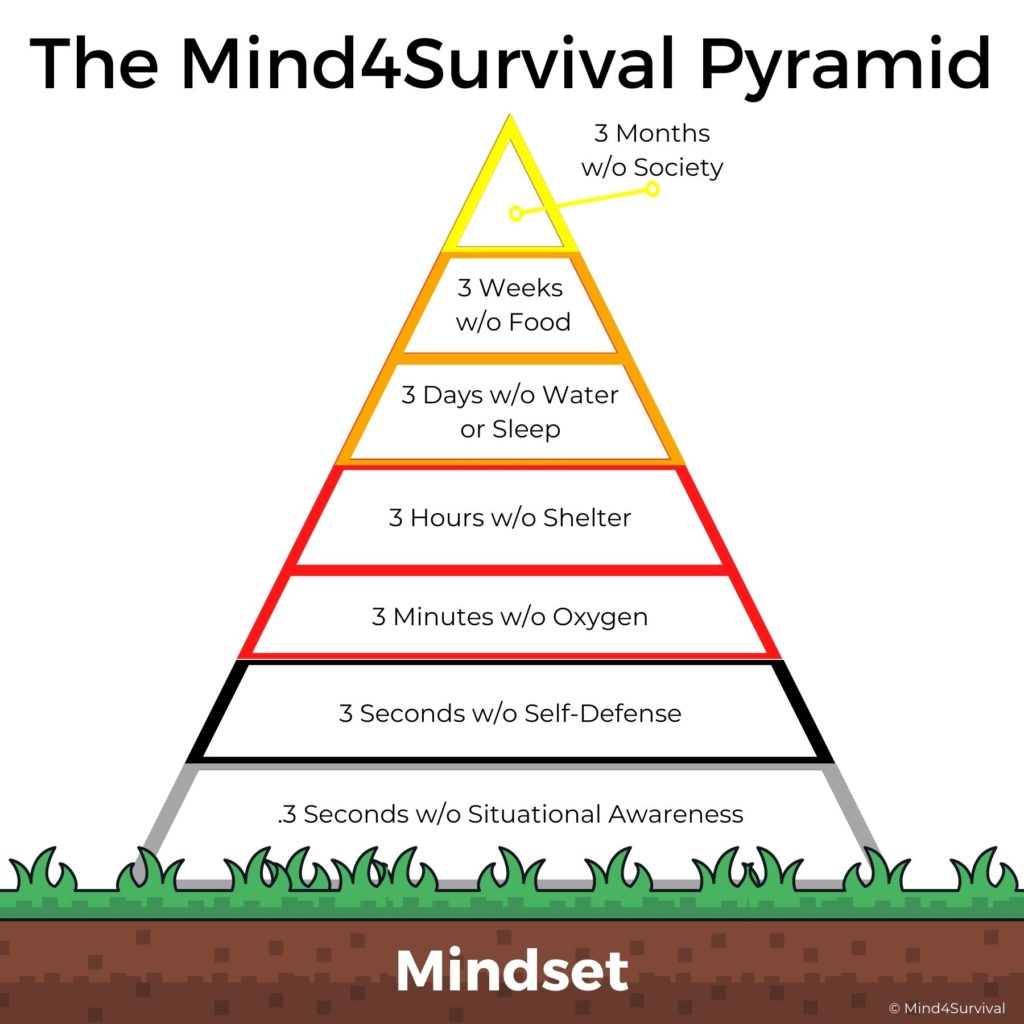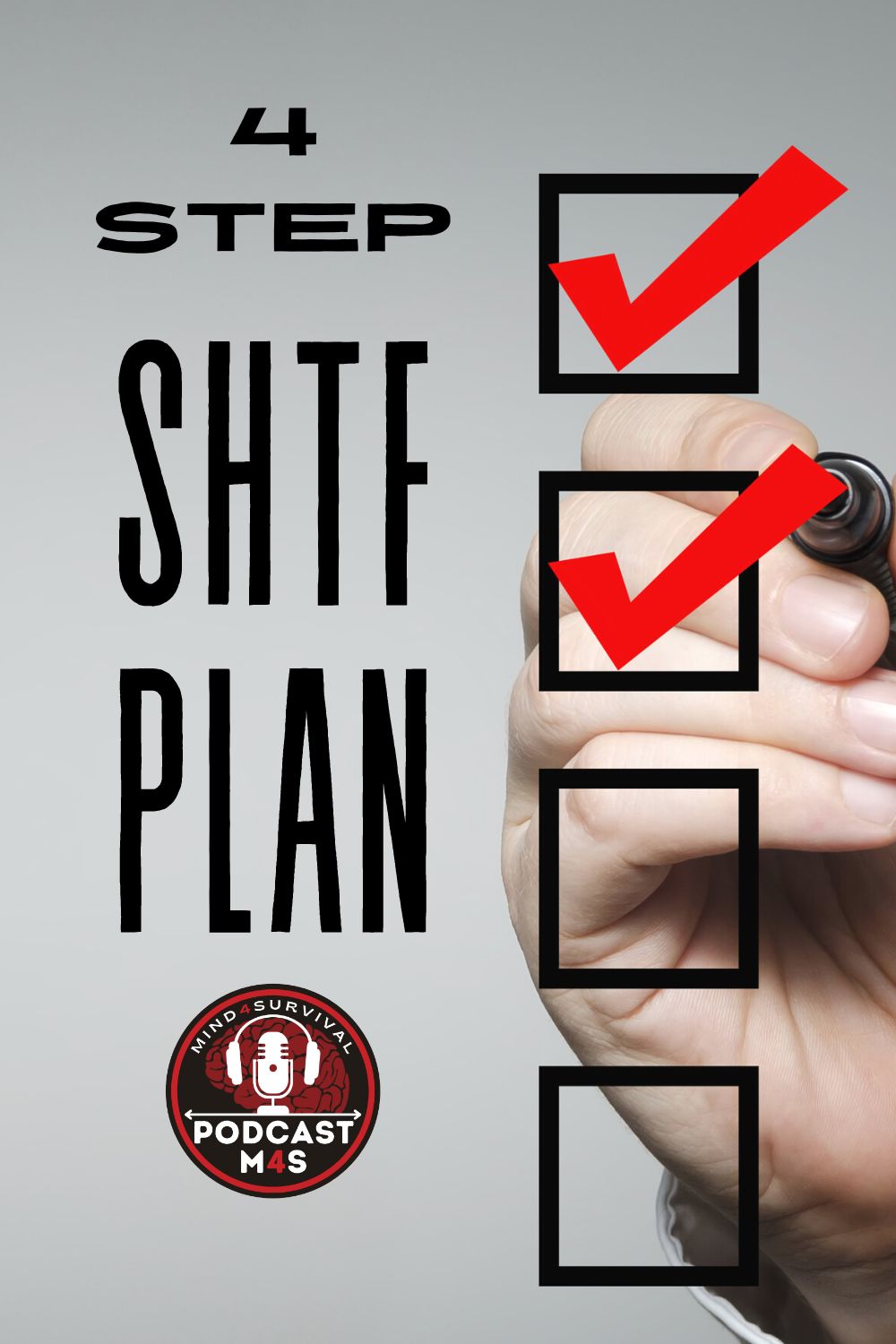SHTF Plan: 4-Step Planning Guide for Surviving SHTF


Podcast: Play in new window | Download
Everyone needs an SHTF plan (Shit Hits the Fan Plan) because society is much more fragile than many people understand or want to believe. Our stark reality is one in which a single large-scale disaster or series of smaller-scale disasters occurring in the wrong place at the right time can lead to cascading impacts on society.
When that happens, those who don’t have an SHTF plan ready to go will be much more likely to suffer. Those without an SHTF plan are more likely to struggle and succumb to a lack of planning and preparation.
The solution is this step-by-step process to survive any SHTF situation. This four-step guide will help ensure you and your loved ones are safe and sound when the world around you descends into chaos.
What Is an SHTF Event?
An SHTF event is any event that exceeds the ability of local, state, national, and international aid providers to overcome. SHTF events cause widespread regional, national, and international harm, and the damage they cause is beyond society’s capacity to address.
When discussing SHTF events, most people think of them as large-scale disasters such as a supervolcano eruption, significant asteroid impact, or a similar cataclysm. While this is true, smaller, compounding disasters can build upon one another to the point they result in an SHTF situation occurring.
Here are a few examples of possible SHTF events:
SHTF Scenario #1 – Large-Scale Natural Disaster
Large-scale natural disasters are both possible and have occurred throughout history.
Examples of large-scale natural disasters are the eruption of a supervolcano, widespread infection with a highly deadly virus with a 40% death rate, and the impact of a 3-mile-wide asteroid, all of which have occurred throughout history.
SHTF Scenario #2 – Large-Scale Human Disaster
Historically, large-scale human disasters were only able to happen due to the actions of a nation-state. For example, nuclear and biological warfare, kinetic activities, etc., were only able to be initiated by the actions of a country.
Now, however, technology is continually increasing the potential for individual and non-nation-state actors to initiate large-scale disasters worldwide.
Some examples of large-scale human disasters include:
- A cyberattack that permanently shuts down The Eastern Grid, resulting in loss of power to most of the U.S. east of the Rockies.
- The manipulation and collapse of national and international financial systems.
- Rogue nations use nuclear or biological warfare against their enemies.
SHTF Scenario #3 – Compounding Small-Scale Disasters
Compounding small-scale disasters occur when one small-scale problem leads into or provides the circumstances for another small-scale compounding disaster to happen. In turn, the newly ensuing disaster sets the stage for yet more problems and disasters to occur, eventually resulting in widespread problems and potential SHTF scenarios.
Examples of compounding small-scale disasters that may lead to large-scale SHTF scenarios include:
- A nation suffers from a severe economic collapse. In response to the struggle within the nation, a charismatic local leader comes to power. In a quest to unite and expand his country, that leader vilifies a people within the country and begins looking outward. As a result, millions of people march off to gas chambers, and a world war SHTF event is started.
- A virus leaks from a lab in one country and begins to spread globally. As a result, governments start making politically expedient decisions that cause global political and financial strife. In turn, the strife leads to social upheaval around the world, eventually resulting in civil wars and the collapse of society as we know it.
- One nation postures as if it will invade a smaller neighbor. Other nations respond by increasing rhetoric and moving troops into the region. A random encounter between opposing armies spills over into conflict between several countries that result in a nuclear war.
Timeline of Wide-Scale SHTF Situations
Many experts warn that following the downing of national power grids, upwards of 90 percent of people will have died during the first year, and society as we know it will have collapsed.
Therefore, regardless of the SHTF scenarios considered, any that result in the collapse of society will result in large-scale death and destruction for the 332 million people currently living in the U.S.
With that, given a grid-down scenario, it’s fair to assume these benchmarks for the destruction of society following an SHTF event.
Phase 1: 0 – 7 Days | 1% of the Population Will Perish (3M People)
Deaths will be limited to those dependent upon infrastructure, such as patients on life-support, requiring supplemental oxygen, etc.
When the grid first fails, violence will be minimal. However, as the time from the initial failure of the grid increases, civil society and the rule of law will give way to increasing violence and chaos.
This is the most critical phase for decision-making for people who plan for SHTF events. The decision is whether to shelter in place (bug-in) or leave your home behind (evacuate / bug-out).
The problem is that if you don’t decide, as soon as possible, to leave your home due to a devolving situation, your area may become extremely dangerous and uninhabitable due to violence and lack of resources.
With that, we’ll cover the planning and decision-making about bugging in and bugging out in the SHTF Planning process below.
Phase 2: 8 – 28 Days | 33% of the Population Will Perish (110M People)
An SHTF event’s most significant and immediate impact will be on the 332 million people across the United States. As such, widespread death and destruction will wreak havoc in cities due to violence and lack of resources such as medicine, food, etc.
Likewise, there will be a similar effect in rural areas, but not as profound, due to lesser violence and increased resource opportunities such as food, etc.

Phase 3: 29 – 90 Days | 33% of the Population Will Perish (110M People)
Cities will be nearly empty, resource-bare, death traps. While violence will decrease due to a reduction in population, the lack of water, food, and the rule of law will make once-flourishing cities nearly uninhabitable, except for the most prepared.
Likewise, rural populations will see increased violence as refugees from urban areas flood out of the cities into the surrounding areas. The increasing violence and lack of resources such as food will result in the further breakdown of society.
Phase 4: 91 – 365 Days | 20% of the Population Will Perish (60M People)
Society will continue to collapse until it eventually stabilizes near the levels of the rural population of the 1900 census, which was 50 million people in the United States.
The SHTF Planning Process
Now that we know what an SHTF event is and have a timeline of how it may occur, it’s time to focus on your SHTF planning process.
There are five steps to a successful SHTF plan.
Step 1: Acknowledge That You Need an SHTF Plan
Deciding that an SHTF plan is needed is the first step in planning for an SHTF event.
Unfortunately, many people suffer from normalcy bias and other aspects of the human condition, which prevent them from facing the potential for large-scale disasters. As such, they go through life largely unprepared and dependent upon others in times of need and other emergencies.
Fortunately, since you’ve read this far, you are not one of those people. Instead, you understand the need to prepare for disasters that are too horrible for many people to consider.
Step 2: Decide on a Course of Action
Situational awareness is essential for any emergency situation. Therefore, it’s crucial to assess the situation before creating a plan. This is especially true in an SHTF scenario when resources may be limited, and conditions can change rapidly.
By taking the time to assess the situation, you can gather information about potential threats, identify risks, and determine the best course of action. This will help ensure that your plan is as effective as possible and that you are prepared for whatever comes your way.
Here’s a great, Step-By-Step Prepping Survival Guide Article
Step 3: Prepare Your SHTF Plan Based on the Survival Pyramid
Now that you’ve made your assessment, it’s time to ensure that your plan meets your basic survival needs. The best way to do this is by using The Mind4Survival Pyramid, or “Survival Pyramid,” for short.
The survival pyramid, based upon the survival rule of threes, provides a hierarchy to address your basic needs in their order of importance.

The survival pyramid provides an easy-to-remember reminder of what’s most important to survival. And it provides that information in a logical progression ranked by what the next lacking of something will kill you.
Mindset
Mindset is the foundation of basic preparedness. A good mindset allows us to be better prepared to recognize, prepare for, and deal with problems both during the disaster and in its aftermath.
Action: Because you’ve acknowledged the need for an SHTF plan, you’ve already checked the Mindset box!
Situational Awareness
Situational awareness (SA) is our most immediate survival need. Less than a third of a second without SA, and we will not be ready if disaster strikes. And, if you’re not prepared when tragedy happens, you’re dead. Once you’re dead, all of the survival skills, money, and supplies don’t matter.
Action: Fortunately, you’ve already checked the awareness box by assessing what’s happening and working to plan ahead (right now) to deal with it. Keep it up!
Immediate Action: Self-Defense
Once you become aware of a situation, you must be able to deal with it. If you’re being attacked, do you know enough self-defense to survive? A person with a weapon or the right knowledge can kill and incapacitate you within three seconds. The ability for someone to have the capability (knowledge and ability) to defend oneself cannot be understated.
Action: Confirm you have basic survival skills and a good everyday carry (EDC) setup. Seek out different types of self-defense training.
Oxygen
The next thing that can kill you is a lack of oxygen in your brain. When the brain goes without oxygen, a series of problems incompatible with life begins.
The problems, by time, associated with oxygen deprivation are: (Source)
- 30 seconds: loss of consciousness possible.
- 1 minute: brain cells begin to die.
- 3 minutes: brain damage becomes more likely.
- 5 minutes: death becomes imminent.
- 10 minutes: severe brain damage is almost inevitable.
- 15 minutes: survival is nearly impossible.
In short, if an attacker or an oxygen-depleted environment cuts off our oxygen supply, we can be rendered unconscious in 30 seconds and will suffer brain damage within three minutes.
Action: Learning how to use a first aid kit / trauma kit to stop massive bleeding, which kills someone within 3 minutes due to oxygen-carrying blood leaving the body, is essential. Learning CPR to help circulate other people’s blood carrying oxygen when they aren’t circulating it is also essential if you want to save your oxygen-deprived family members.
Shelter
In extremely cold temperatures, a lack of shelter can kill within an hour. Therefore, after oxygen to the brain, the next most critical survival need is shelter.
There are two forms of shelter. The first is the clothes we wear. The second is the structure we reside in, which protects us from the environment.
Protection from the environment includes cold, heat, wind, rain, two-legged humans, four-legged predators, and all other biting, stinging, and envenoming creatures.
Action: Consider shelter as protection much more than just protection from the weather. It can provide physical security as well. Therefore, be deliberate about your shoe and clothing choices. Likewise, always plan and be ready to provide shelter for yourself.
Sleep and Water
Three days without sleep or water can incapacitate and lead to death. People who go 72 hours without sleep can begin to experience hallucinations. Hallucinations can lead to terrible outcomes when added to our disaster decision-making process. Seeing people who aren’t there, doing things that aren’t real, and then making a decision based upon our alternate reality is a bad thing when the chips are down.
Likewise, the longer we go without water, the more difficult it becomes to carry out needed tasks. Eventually, sometime before going three days without water, we’ll experience decreased effectiveness and mental clarity and be well on our road to death.
Action: Always have a plan for water and sleep. Perhaps that means carrying water with you or the means to gather and filter water. Likewise, the capability to provide yourself with a secure area to get rest is important and reinforces the need for proper shelter.
Food
Food provides the energy we need to survive. Without food, we will lose energy and survival effectiveness within a few days. Therefore, after water and sleep, we need to ensure that we have enough food to maintain peak effectiveness.
Action: Store enough food to survive as long as you envision remaining in your home. Don’t forget, if you stay more than a few days in your home at the beginning of the societal collapse, you may be stuck there until the area clears out, people die off, and the situation settles down.
Society
We are a social species. Likewise, we all encounter problems that require the help of others to survive. Therefore, we need people and a plan to ensure we have some form of society to rely upon. What if you fall ill or become injured and need someone else to help take care of your basic needs? Is it wise to have someone awake 24 hours a day to secure your home or area? If so, you’ll need someone to help.
Action: Work on building friendships with others of similar values. Begin establishing a network or community of people to rely on when the chips are down. Start with your family and network of friends and expand from there.
Establish Tripwires
You will also need to establish tripwires for your SHTF survival plan. 
Making decisions with severe consequences during times of struggle can be difficult. Therefore, we all need a plan that helps minimize the impact of emotion on our consequential choices.
Tripwires are non-negotiable situations that occur, which tell you that it’s time for action, no questions asked. Tripwires are your lines in the sand for taking action when a pre-determined event or situation occurs.
Your tripwires may include events such as:
- Local authorities recommend people shelter in place.
- Reports of law enforcement personnel not reporting for work.
- An incident that has the potential to cause widespread damage happens within a pre-set distance of your home.
- Any situation that begins to spiral out of control of local and regional authorities to manage.
Actions as a result of your tripwire activations may include:
- Have your family gather at your home.
- Reviewing your plans
- Adding to your home security posture
- Loading your supplies into your vehicle
- Leaving your home behind
It’s important to understand that the use of tripwires is essential in the first phase (0 – 7 days) of any serious event. It’s vital because the more the rule of law gives way to desperation and violence, the lower a person’s chances of escaping to safety.
Therefore, the best option to address your risks of remaining in the danger zone is to plan for the possible scenarios now, establishing tripwires that you can enact at a moment’s notice.
Create a PACE Plan
PACE planning is a planning process that helps you consider your response to problems that may arise when carrying out your initial plan.
Since we already know the risk to ourselves and our family’s survival increases over time, we must plan for options should our current plan become ineffective.
PACE stands for Primary, Alternate, Contingency, and Emergency.
In the case of an SHTF event, a PACE plan may look like this:
Primary Plan – Shelter in Place
All family members will remain in the home and carry on with as normal a life as possible. We will maintain SA by gathering as much information as possible about the current situation. Should any of our tripwires be crossed, we will launch the next phase of our PACE plan.
Alternate Plan – Planned Evacuation
Should our community become too dangerous, we will evacuate to our pre-determined safe shelter bug-out location. Before leaving, we will quietly and covertly pack all the supplies (survival supplies, self-defense gear, and aid kit) in accordance with our vehicle load plan. Before leaving, we will secure our home and attempt to hide any remaining supplies in case we must return.
Contingency Plan – Hasty Evacuation
If the safety and security of our situation rapidly degrade, we will perform a hasty evacuation of our home. During a sudden evacuation, each person will gather their survival gear and bug-out bag. Keeping security in mind, we will load up and leave the area using the safest of our pre-determined routes. The immediate goal of our hasty evacuation is to exit the area of developing disaster or civil unrest. We will reevaluate our situation and enact follow-on plans once we’re out of danger.
Emergency Plan – Fortify in Place
The situation has declined to the point that it is safer and better to remain in our home than evacuate. As such, we will fortify our home and live off our pre-set supplies. We will follow noise and light discipline rules and will have a 24-hour guard to monitor our home and perimeter. All family members will remain inside the home. We will continually collect information to determine our follow-on courses of action.
Note: This is one example of a possible PACE plan. Your plan may look much different and should be based on your situation and risk profile.
Step 4: Take Action
Now that you’ve addressed the survival pyramid and have your tripwires and PACE plan in place, it’s time to take action. Start checking off your survival needs and preparing to do your best when things are at their worst.
The Bottom Line of Creating Your SHTF Plan
The SHTF Plan is a guide to help you survive any disaster or emergency. By following these simple steps, you can ensure that you and your loved ones will be more safe and sound during times of chaos.
Additional Resources:
- Situational Awareness Focused: Create your own risk assessment
- Self-Defense Focused: Jiu-Jitsu with Gracie University
- 3-Minutes w/o Oxygen Focused: Stop The Bleed courses
- 3-Minutes w/o Oxygen Focused: Find CPR classes near you
Stay safe,


5 Comments
Leave a Comment




Join Mind4Survival!
Stay informed by joining the Mind4Survival! 100% Secure! 0% Spam!
Follow Us!
Affiliate Disclosure
Mind4Survival is a free, reader-supported information resource. If you make a purchase through our link, we may, at no cost to you, receive an affiliate commission.






I’ve been prepping for a long time but I’ve never been able to flesh out my plan to my satisfaction. I’ve struggled with the format and content for a long time. I knew what I wanted to accomplish in my head but translating into a written format was driving me nuts. So I’m road tripping the other day and dial up your latest podcast and wala! This has helped me with the format and content. For some reason something just clicked and it just came flowing out of my head and onto paper. The examples you gave in the PACE plan did the trick. I’ve recommended this podcast to a bunch of people from long time peppers I know to people who have never thought about preparedness and got a lot of great feedback already. In short I just wanted to say say thanks brother. I think you may have just saved my life. We’ll find out in the end.
Thanks! That is THE BEST compliment I can imagine receiving. Keep up the great preparedness! ~Brian
Why do we not have patriots in groups all across this nation trained armed and ready for what see is coming. If we do I want in.
I have been enjoying this site for a few months now and I wish to thank you for your insights and information.
However, as an “old fart” (70’s) and female, who has been what is now called “Prepping” since I was 10 – today’s goto mindset seems to be technology.
This is bad, as many of the situations I have been in over the decades have been ones where technology – even today’s satellite technology, have been mostly useless.
Basically you have to survive just to reach an area where even spotty technology is possible or until you can build/create/make your own “technology” – all while trying to avoid becoming “prey” to any 4 and or 2-legged creatures that could be out there AND the weather AND water and food – just to name a few basic survival obstacles.
Some examples of situations I’ve been in (can’t go into detail as it would take too long):
Backpacking in Glacier National Park we had hiked to a small lake off the Rainbow Glacier and then inflated a canoe to get to a little island in this lake. We were exploring the island, foraging and fishing for food. This was a time frame when cell phones were those big suckers kinda like the old military “portable” radios – don’t know if the area has cell or satellite service today or not. While camping there was a horrendous thunderstorm which started a forest fire near us. We were fairly sure we were safe from the fire, however after the first day of the fire, the smoke was getting very thick. We decided to pack up and get back to the “mainland” and proceed away from the fire. Somehow we had punctured the canoe and could not get off the island. We started to build us a raft to get us back to the “mainland”. Needless to say the next two days were stressful as we tried to fish, forage and build the raft – all while keeping track of the fire as best we could. We eventually heard someone hiking on the shore of the lake. In those days we had to log our itinerary with the rangers before heading out and yes they were looking for us. Our “SOS” flags, which we flew from some sapling trees, had alerted the fire crews and rangers of our location.
Backpacking in the Canadian Rockies with a small group and our guide, the most experienced of the group who got injured when an earthquake hit. None of the rest of us knew the area and I was the only other person who could read a topo map and use a compass – however I was also the youngest. The “Mounties” had the sat phones of the 60’s, as did our guide, however the earthquake took out the towers closest to our position AND it also altered the course of the river we were backpacking along – the whole dang blasted area we were in was changed topographically!!!! Turns out the river shifted about a mile north and west, one half of the (once) shallow valley sank 40 feet and the east side uplifted close to 30 feet. Landmarks were altered … it took me 2 and half days to find the closest Mountie station (which sustained damage) and I swear to this day that I think I traveled half of that in circles!!!! By the time I got back with the Mounties and supplies the others had been without food for a full day – at least they had water.
Camping in the Black Canyon of Gunnison Colorado with my then around age 10 children: We had to park on the upper lot and set up camp on the opposite side of the river in the canyon in order to have an elevated tent site. This entire camping area had NO cell and sporadic satellite service due to the canyon. A gully washer came through and wiped out the foot bridge and stranded us and two other camp sites on our side of the river. The parking lot side was just about destroyed as it was much lower than our side and the lower parking lot was completely destroyed – since we parked on the upper lot our vehicle was spared. Because I always plan, supply wise, for 2 additional adults and 2 additional days – we had enough supplies – however the other two campsites on our side lost some of their stuff to the flooding as they were lower down than we were and the choppers dropped them replacement supplies. They couldn’t get us out for a couple of days and eventually got us out by chopper. We all had to wait another week to get back there to get our camping gear out.
Any way that is my insight and thoughts and keep up the great job !!!!!
May God bless you and yours always,
Mima Criss
brian, have followed you awhile now, learned some things also. we are 2 oldsters, hard to get around….have some preps done, but here’s couple questions: 1. we have nowhere to bug out to, wouldnt be able to get to mtn family, so stay home; 2. how would you approach the subject of prepping, security, etc with neighbors you dont know well…how they feel about it, could we all join together in one residence when something happens, etc. dont know who to trust or how to approach…
dont like where things are headed….thanks for any advice …dont like the feeling I have either…..